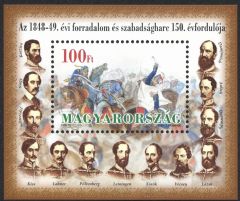The 150th anniversary of the Hungarian Revolution and War of Independence of 1848-49
"With this act the civil reshuffle and the peaceful building of country could have been started. The Court of Vienna, however, regretted soon its compliance and incited the ethnic minorities with money and promises to rebel against the government. The nation became independent only for a short time and it had to defend itself immediately. The Hungarian Army set up in haste gained its first victory on September 29th 1848 in the battle of Pákozd, when Jellasics, viceroy of Croatia stopped his army of 34 thousand and forced them to leave the country. The commanders of the old school could not take advantage of the victory, and they soon had to withdraw at every front. The only exception was General József Bem who following his appointment as commander-in-chief of the Hungarian Army of Transylvania cleared the whole Transylvania from the enemy in a few months. Already with new commanders the series of victorious battles of the Hungarian Army started in April 1849 also in the internal part of the country. Due to the victories in Hatvan, Tápióbicske, Isaszeg, Vác and Nagysalló gained during the spring military expedition almost the entire country became cleared from the enemy. At this time Emperor József Ferenc applied to the Russian Tsar for help, who sent an army of 200 thousand to suppress the Hungarian War of Independence. Before the multiple superior force the poorly armed Hungarian revolutionary army laid down the arms on August 13th. One did not have to wait for long for the revenge by the Emperor: 12 Hungarian Generals and a Colonel who took part in the victorious battles were put to death at his command on October 6th. When designing the block of stamps the artist used the watercolour titled ""The Battle at Tápióbicske"" by Mór Than and the lithography ""The Thirteens of Arad"" by Miklós Barabás. On the denomination of HUF 24.- of the series of stamps the portrait of Artúr Görgey can on the basis of the lithography of an unknown master be seen, and near the portrait the cavalry officer sword of Görgey provided with a magnifier is shown. On the denomination of HUF 27.- the portrait of Lajos Batthyány is shown, which is depicted by the artist with the use of a lithography after the painting of Miklós Barabás, and near the portrait we can see a handcuffs-formed golden and citrin bracelet originating from the 1850s. The subprint of the stamp illustration is made on the basis of the extradition authorization of the corpse of Batthyány (extract). On the denomination of HUF 32.- the portrait of General Bem is depicted with the use of the watercolour of Mór Than, and beside it the distinction of Bem, the rank no. 1 of the Hungarian Military Decoration can be seen. As the subprint of the stamp illustration, the artist depicted the moment of the handing over of the distinction by using the lithography made after the painting of Pál Böhm. The original copies of the objects and works of art utilized for the designs of the stamps can be found in the collection of the National Museum of Hungary. "
| Type | special stamp block |
| Short description | As a result of the 1848 European revolutionary movements and the revolution in Pest the King appointed on April 7th the first independent responsible government. |
| Printing Office | Pénzjegynyomda |
| Perforation Sizer | 38,33 x 30 mm |
| Stamp Circulation | 150000 |
| Theme | history |
| Designer | Tamás Tőkés |
| Stamped/Uncanceled | mint |


